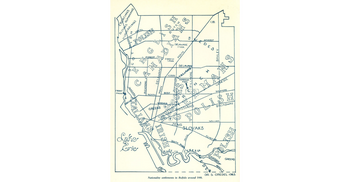Buffalo’s Neighborhoods: Exploring Our Migrant & Immigrant Heritage

Buffalo’s diverse ethnic neighborhoods were built by generations seeking opportunity and a better way of life. As these communities grew and evolved, their imprint on the region could be felt economically and culturally, with newspapers, festivals, stores, restaurants, churches, and most importantly the people contributing to the rich fabric of our city.
Among the area’s first inhabitants were the Seneca, an Iroquoian-speaking people that settled in Western New York and known as the “Keepers of the Western Door” in the Six Nation Haudenosaunee Confederacy. Later, a number of New Englanders arrived and established the Village of Buffalo. The first wave of European immigrants was a large influx of Germans. The city was further populated by Irish immigrants, who were among those who built the Erie Canal, and later infused by Polish, Italian, and Jewish immigrants, as well as a small community of Black migrants that established themselves early in Buffalo’s history, many believed to have escaped enslavement in the South.
During the 1800s, immigrants from European countries came in waves as they fled famine, job shortages, rising taxes, and persecution that arose in their home nations, playing key roles in building the Erie Canal, scooping grain and building railroads. With the opening of the Erie Canal in 1825, Buffalo became a busy port city, enticing others with seemingly boundless opportunity.
The 1870s and 1880s saw the next big wave of immigrants, who settled the waterfront and east side neighborhoods, and established churches, community centers, and charitable organizations. From the turn of the 19th century until the City’s population peaked in 1950, Black migrants continued to come, drawn by the prospect of jobs in Buffalo’s factories and industry. This was part of a larger movement in the United States, the Great Migration, in which Black families left the rural south and headed north to industrial cities in search of prosperity.
Even as the various waves of immigrants and settlers prospered and moved throughout the region, their established traditions and community connections continued to endure.
This collection explores and celebrates the people and heritage of the City of Buffalo utilizing materials from the Buffalo & Erie County’s Special Collections Department as well as resources generously shared by the Western New York Genealogical Society (WNYGS), The Buffalo Genealogy Society of the African Diaspora (BGSAD), The Buffalo Irish Genealogical Society (BIGS), The Iroquois Genealogy Society, The Italian Genealogical Society of Western New York, and The Polish Genealogical Society of New York State (PGSNYS).
Leatha Jimerson, Iroquois Genealogy Society;
Sandi Russo, Italian Genealogical Society;
Angelo F. Coniglio, Italian Genealogical Society;
Translators: Klara Frank, Dr. Elke Hedstrom